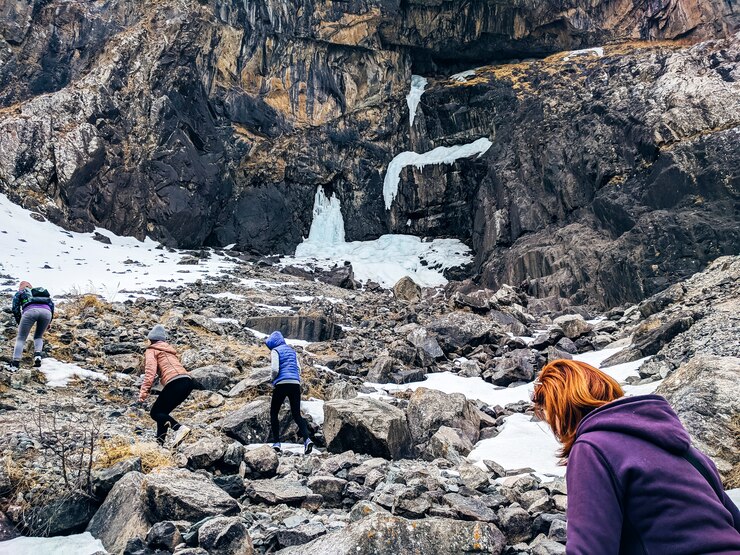The journey from Lukla to Lhotse, traversing the 15 day trek to Everest Base Camp trail, unveils a stunning tapestry of natural beauty and cultural richness. This trek, spanning from the vibrant gateway of Lukla to the majestic Lhotse, showcases an incredible range of landscapes, each offering its own unique charm and challenge.
Starting in Lukla, the adventure kicks off with a thrilling flight that lands in this tiny mountain town, perched at 2,860 meters (9,383 feet). Known for its famously short and steep runway, Lukla is the gateway to the Everest region and a bustling hub where trekkers gather. The initial stretch of the trek is characterized by lush green forests and terraced fields, offering a stark contrast to the towering peaks that lie ahead. As you leave Lukla, the trail meanders through charming Sherpa villages like Phakding, where traditional houses and vibrant prayer flags offer a glimpse into local life.
Ascending from Phakding, the route follows the Dudh Koshi River, crossing suspension bridges that sway above roaring rapids. The trek gradually climbs through rhododendron forests and pastancient monasteries, leading to Namche Bazaar, a lively trading post and acclimatization hub. Nestled in a high-altitude basin, Namche offers breathtaking views of the surrounding peaks, including the towering Ama Dablam. This vibrant town, with its market stalls and local cafes, provides trekkers with a chance to acclimatize while soaking in the vibrant culture of the Khumbu region.
Beyond Namche, the trail continues through a series of small villages and alpine meadows, with each step offering increasingly dramatic views of the Himalayas. The trek crosses into the higher elevations of Tengboche, home to a renowned monastery with panoramic views of Everest and Lhotse. The spiritual atmosphere of Tengboche, combined with its awe-inspiring backdrop, sets the stage for the trek’s final ascent.
As you move further, the landscape transitions to stark, barren terrains as you approach the Khumbu Glacier. The trail becomes more rugged and exposed, with the majestic icefall and the towering Lhotse face dominating the horizon. The sheer scale of Lhotse, the fourth-highest mountain in the world, creates a dramatic backdrop for the final stretch towards Everest Base Camp.
Reaching Lhotse, the trek culminates with the awe-inspiring vistas of the Everest region, where the sheer cliffs and glacial landscapes create a surreal and breathtaking experience. Documenting this journey from Lukla to Lhotse captures not only the diverse beauty of the trail but also the profound sense of accomplishment and connection with one of the most iconic mountain landscapes on Earth. The varied terrain, from verdant forests to stark high-altitude deserts, mirrors the adventure and spirit of exploration that defines the Everest Base Camp trek.
Introduction to the Everest Base Camp Trail
The Everest Base Camp trail is a legendary trekking route that offers an unparalleled journey into the heart of the Himalayas. Stretching approximately 130 kilometers (80 miles) round trip, this trek leads adventurers from the bustling city of Kathmandu to the serene base camp of the world’s highest peak, Mount Everest. The trek typically spans 12 to 14 days, including acclimatization days, and takes trekkers through a diverse range of landscapes, from lush forests and terraced fields to rugged high-altitude deserts and glacial valleys. Each stage of the trail reveals a unique facet of the region’s natural beauty and cultural richness. Starting from the small town of Lukla, trekkers embark on a journey that includes vibrant Sherpa villages, ancient monasteries, and breathtaking vistas of towering peaks like Ama Dablam, Nuptse, and Lhotse. The trail’s gradual ascent allows trekkers to acclimate to the increasing altitude while immersing themselves in the rich traditions of the local Sherpa people. The journey culminates at Everest Base Camp, where climbers and trekkers alike gather to witness the majestic views of Everest and the surrounding peaks, making it a rewarding experience for those seeking both adventure and spiritual connection in one of the world’s most awe-inspiring landscapes.
Lukla: Gateway to the Adventure
Lukla is the gateway to the 14 day Everest Base Camp trek, serving as the starting point for this epic journey into the Himalayas. Nestled at an altitude of 2,860 meters (9,383 feet), Lukla is a small, bustling town renowned for its airport, which is considered one of the most challenging in the world due to its short, steep runway. This lively hub is where trekkers from around the globe converge before embarking on their trek. The town itself is vibrant, with a mix of teahouses, shops, and local lodges catering to the needs of trekkers. The atmosphere in Lukla is both exciting and anticipatory, as it marks the beginning of a grand adventure. Beyond the airport, Lukla offers glimpses of traditional Sherpa life and stunning mountain views that set the stage for the trek ahead. The trek from Lukla starts with a descent into the lush valley of the Dudh Koshi River, leading to a mix of steep ascents and gentle climbs that prepare trekkers for the challenges of the trail. Lukla’s significance extends beyond being a mere starting point; it is a vibrant gateway that captures the spirit of adventure and the promise of the majestic Himalayas that lie ahead.
Phakding: The Serenity of the Dudh Kosi River
Phakding is a picturesque village along the Everest Base Camp trail, situated at an elevation of 2,610 meters (8,563 feet). Nestled in a serene valley beside the Dudh Kosi River, Phakding offers a tranquil respite on the journey from Lukla. The village is characterized by its traditional Sherpa architecture, including charming wooden houses and colorful prayer flags fluttering in the breeze. The gentle, rhythmic sound of the Dudh Kosi River, which means “Milk River” due to its milky appearance from glacial silt, creates a calming ambiance that contrasts with the excitement of the trek’s beginning. Phakding serves as a crucial acclimatization stop where trekkers can adjust to the altitude and prepare for the more challenging parts of the trek. The village is surrounded by lush forests and terraced fields, providing scenic views and a sense of peace. Several teahouses and lodges in Phakding offer comfortable accommodations and a chance to experience local hospitality. As trekkers stroll through the village, they are greeted by friendly locals and can enjoy the beautiful natural setting that marks the start of the trek into the high Himalayas.
Namche Bazaar: The Vibrant Hub of Sherpa Culture
Namche Bazaar, situated at an altitude of 3,440 meters (11,286 feet), is a bustling and vibrant town that serves as the cultural and economic hub of the Khumbu region. This strategically located settlement is a key acclimatization stop for trekkers en route to Everest Base Camp. Namche Bazaar is renowned for its lively market atmosphere, where traders from the surrounding villages come to sell goods ranging from local produce to trekking supplies. The town is a fascinating blend of traditional Sherpa culture and modern amenities, featuring a variety of shops, cafes, and lodges. The architecture of Namche Bazaar is distinctive, with traditional Sherpa houses built in a terraced manner on the steep slopes. The surrounding landscape offers stunning views of the Himalayas, including the iconic peak of Ama Dablam. Namche is not only a place for rest but also a cultural immersion; visitors can explore local monasteries, such as the Namche Monastery, and experience the vibrant local customs and festivals. This vibrant hub provides trekkers with both a much-needed rest and an opportunity to engage with the rich Sherpa culture before continuing their ascent toward Everest Base Camp.
Tengboche Monastery: Spirituality Amidst the Peaks
Tengboche Monastery, located at an altitude of 3,867 meters (12,684 feet), is one of the most spiritually significant and picturesque locations along the Everest Base Camp trail. Perched on a ridge with panoramic views of the surrounding peaks, including Everest, Lhotse, and Ama Dablam, this renowned Buddhist monastery offers a unique blend of spiritual tranquility and breathtaking natural beauty. Founded in 1916, Tengboche Monastery serves as a central hub for the Sherpa community, playing a key role in their religious and cultural practices. The monastery’s main temple, adorned with intricate murals and traditional Tibetan art, provides a serene setting for prayer and meditation. Visitors to Tengboche often have the opportunity to witness traditional Buddhist ceremonies and rituals, which offer insight into the spiritual life of the Sherpa people. The views from Tengboche are spectacular, with the majestic peaks of the Himalayas forming a dramatic backdrop that enhances the monastery’s spiritual ambiance. This stop not only allows trekkers to rest and acclimatize but also provides a deep connection to the local culture and spiritual heritage of the Everest region.
Dingboche: The Panoramic Views of the Himalayas
Dingboche, situated at an elevation of 4,410 meters (14,470 feet), is a scenic village that offers some of the most breathtaking panoramic views along the Everest Base Camp trek. Nestled in a high-altitude valley, Dingboche provides trekkers with a vital acclimatization stop and a chance to rest before continuing the ascent to Everest Base Camp. The village is surrounded by stunning landscapes, including the imposing peaks of Ama Dablam, Lhotse, and the north ridge of Everest. The clear, crisp air and the expansive vistas create a sense of awe as trekkers gaze out over the dramatic Himalayan terrain.
Dingboche’s unique location provides a natural amphitheater of snow-capped peaks and rugged ridges, making it an ideal spot for acclimatization hikes. Popular trails from Dingboche include the climb to the Nangkar Tshang Viewpoint, which offers sweeping views of the surrounding mountains and the Imja Khola valley. The village itself is home to several lodges and teahouses that offer comfort and warmth, allowing trekkers to enjoy the local hospitality while soaking in the majestic surroundings. Dingboche is more than just a stop on the trail; it’s a place where the grandeur of the Himalayas can be truly appreciated and where the journey’s altitude and physical demands are balanced by the beauty of the high-altitude environment.
Lobuche: The Gateway to the Khumbu Glacier
Lobuche, perched at 4,940 meters (16,207 feet), serves as a critical waypoint on the trek to Everest Base Camp and is known as the gateway to the Khumbu Glacier. This small, rugged settlement offers trekkers a glimpse of the vast, icy expanses of the glacier and provides a crucial rest stop before the final push to Everest Base Camp. The trek from Dingboche to Lobuche is characterized by increasingly rugged terrain, with the path winding through a landscape of moraine and rocky outcrops.
The views from Lobuche are awe-inspiring, with the Khumbu Glacier and its surrounding peaks dominating the horizon. The glacier itself, with its jagged ice formations and crevasses, is a testament to the immense natural forces at work in the Everest region. Despite its remote and challenging environment, Lobuche offers essential amenities such as teahouses and lodges where trekkers can rest and prepare for the final leg of their journey. The high altitude and harsh conditions make Lobuche a crucial acclimatization point, and the village’s strategic location helps trekkers adjust to the reduced oxygen levels before they tackle the demanding climb to Gorak Shep and Everest Base Camp.
Gorak Shep: The Last Stop Before Base Camp
Gorak Shep, situated at an elevation of 5,164 meters (16,942 feet), is the final stop before reaching Everest Base Camp and offers a crucial resting point on the trek. This small, remote settlement, nestled amidst the rugged terrain of the Khumbu region, serves as the last major checkpoint for trekkers as they prepare for the final ascent to the base camp. The trek from Lobuche to Gorak Shep is challenging, with the path leading through rocky moraine and offering spectacular views of the surrounding peaks, including the iconic Everest.
Gorak Shep provides basic but essential amenities, including lodges and teahouses that cater to trekkers’ needs. The high altitude and cold temperatures make it a stark and windswept location, but the village’s strategic position allows trekkers to rest and acclimatize before the final push to Everest Base Camp. From Gorak Shep, trekkers typically embark on a round-trip hike to Everest Base Camp, which, despite the altitude and strenuous nature, is a rewarding experience offering unparalleled views of the world’s highest peak. The sense of accomplishment upon reaching Gorak Shep, combined with the anticipation of the final leg of the trek, encapsulates the essence of this extraordinary adventure.
Everest Base Camp: The Heart of the Trekking Journey
Everest Base Camp, located at an altitude of 5,364 meters (17,598 feet), represents the pinnacle of the Everest trek and the heart of this iconic journey. As the ultimate destination for climbers and trekkers alike, Base Camp provides an unparalleled vantage point from which to view the world’s highest peak, Mount Everest, as well as the surrounding peaks of the Khumbu region. The base camp itself is a dynamic and bustling hub during the climbing season, with a diverse mix of mountaineers, support staff, and trekkers gathering to experience the grandeur of Everest.
Reaching Everest Base Camp is a profound accomplishment, symbolizing the culmination of a challenging and rewarding journey. The camp offers breathtaking views of the Khumbu Icefall, with its massive ice towers and crevasses, as well as the surrounding peaks of Nuptse and Lhotse. The sense of achievement and the awe-inspiring scenery create a powerful emotional experience for trekkers. The atmosphere at Base Camp is one of excitement and reverence, as it is a place where the sheer scale of the Himalayas and the spirit of adventure converge. Spending time at Base Camp allows trekkers to soak in the panoramic vistas, reflect on their journey, and experience the essence of the Everest expedition.
Lhotse: A Majestic Neighbor to Everest
Lhotse, standing at 8,516 meters (27,940 feet), is the fourth-highest mountain in the world and an awe-inspiring neighbor to Everest. Situated in close proximity to Mount Everest, Lhotse shares much of its climbing route with Everest, making it a significant peak in its own right. The Lhotse face, with its steep and dramatic ice and rock slopes, is a prominent feature visible from both Everest Base Camp and the higher altitudes of the trek.
The majesty of Lhotse is evident from various points along the Everest Base Camp trail, particularly from the vantage points of Gorak Shep and the surrounding areas. The mountain’s sheer walls and imposing presence contribute to the breathtaking scenery that defines the trek. Lhotse’s proximity to Everest enhances the overall grandeur of the Himalayan landscape, offering trekkers an extended view of the high-altitude wilderness and the intricate geological features that shape this iconic region.
Lhotse’s significance extends beyond its visual impact; it represents a formidable challenge for climbers and serves as a testament to the rugged beauty of the Himalayas. For trekkers at Everest Base Camp, Lhotse stands as a majestic and inspiring neighbor, embodying the spirit of adventure and the grandeur of the world’s highest peaks.
Flora and Fauna Along the Trail
The Everest Base Camp trail is not only renowned for its towering peaks but also for its diverse flora and fauna, which add a rich layer of natural beauty to the journey. As trekkers ascend through varying altitudes, they encounter a remarkable array of plant and animal life that evolves with the changing environment.
At the lower elevations, such as near Lukla and Phakding, the trail is adorned with lush, subtropical forests rich in rhododendrons, magnolias, and pine trees. These areas burst into color during the spring, when the rhododendrons bloom, creating a vibrant tapestry of reds, pinks, and whites. As the trek progresses to higher altitudes, the forested landscape transitions to alpine meadows, where hardy shrubs like junipers and small wildflowers, such as edelweiss and blue poppies, thrive in the cooler temperatures.
Wildlife enthusiasts will find a variety of species along the trail. At lower elevations, the area is home to diverse bird species including the Himalayan Monal, the national bird of Nepal, and various pheasants. As trekkers climb higher, they may spot Himalayan tahr, a type of wild goat with impressive curved horns, and the elusive snow leopard in the more remote sections. The trek also passes through the habitat of the red panda, although sightings are rare due to their elusive nature.
The flora and fauna along the Everest Base Camp trail reflect the changing environments and provide trekkers with a dynamic and immersive natural experience, enhancing the overall adventure with each step through this breathtaking landscape.
The Changing Landscape: From Forests to Glaciers
The journey from Lukla to Everest Base Camp is a spectacular odyssey through a series of dramatically changing landscapes, each offering its own unique charm and challenge. The trek begins in the verdant forests of the lower altitudes, where lush greenery and terraced fields define the initial stages. As trekkers advance, the environment transforms, revealing a diverse range of terrains that showcase the natural beauty of the Himalayas.
Starting from Lukla, the trail meanders through dense forests of pine and rhododendron, with the gentle sounds of the Dudh Kosi River accompanying the ascent. The landscape gradually shifts as trekkers climb through the lower alpine zones, where the vegetation becomes sparser and the terrain more rugged. This transition marks the approach to higher elevations, where the lush forests give way to open, high-altitude meadows adorned with hardy shrubs and wildflowers.
As trekkers reach Dingboche and Lobuche, the terrain becomes increasingly arid and barren, reflecting the harsher conditions of the upper altitudes. Here, the dramatic scenery is dominated by stark moraines and rocky outcrops, with expansive views of the surrounding peaks and glaciers. The final approach to Everest Base Camp reveals the sheer majesty of the Khumbu Glacier, a sprawling expanse of ice and rock that underscores the scale and grandeur of the Himalayas. This progression from verdant forests to stark glaciers encapsulates the dynamic and awe-inspiring nature of the Everest Base Camp trek.
Cultural Highlights: Temples and Festivals
The EBC trek is not only a journey through stunning landscapes but also a rich cultural exploration, featuring a variety of temples and festivals that highlight the vibrant traditions of the Sherpa people. Along the trail, trekkers encounter numerous religious and cultural landmarks that offer insight into the spiritual and communal life of the region.
Namche Bazaar, a key stop on the trek, is home to several significant cultural sites, including the Namche Monastery. This prominent Buddhist monastery serves as a center of spiritual practice and offers visitors a chance to witness traditional rituals and ceremonies. The monastery’s impressive location and intricate artwork reflect the deep religious heritage of the Sherpa people.
The trek also passes through Tengboche, known for its iconic Tengboche Monastery. Situated amidst a breathtaking mountain backdrop, this monastery is one of the most important in the Khumbu region. It hosts regular puja (prayer) ceremonies and festivals, including the famous Mani Rimdu festival, which is celebrated with vibrant processions, traditional dances, and religious rituals. This festival, held annually in October or November, offers trekkers a unique opportunity to experience the local culture and spirituality in a festive setting.
Throughout the trek, local festivals and ceremonies provide an immersive experience into the Sherpa way of life, enhancing the journey with cultural richness and deepening the connection between trekkers and the region’s vibrant heritage.
Photography Tips for Capturing the Beauty
Capturing the breathtaking beauty of the Everest Base Camp trek requires a blend of technical skill and creative vision. The diverse landscapes, from lush forests to icy glaciers, provide ample opportunities for stunning photographs. To make the most of your photographic experience, consider a few key tips.
Firstly, use a wide-angle lens to capture the vast, sweeping vistas of the Himalayan landscape. This type of lens is ideal for encompassing the expansive views of mountain ranges, valleys, and glaciers. For close-up shots of flora and fauna, a macro lens can help highlight the intricate details of wildflowers and wildlife.
Lighting is crucial for photography in the Himalayas. Early morning and late afternoon light, known as the golden hours, provide soft, warm lighting that enhances the textures and colors of the landscape. Aim to shoot during these times to capture the most flattering and dramatic light conditions.
To capture the majestic peaks, including Mount Everest, consider using a telephoto lens. This lens allows you to zoom in on distant mountains, highlighting their grandeur and details. Additionally, framing your shots with elements of the trek, such as prayer flags or Sherpa settlements, can provide context and add a personal touch to your images.
Finally, be mindful of the altitude and weather conditions, which can impact both camera performance and your ability to take photos. Protect your equipment from dust and moisture, and ensure you have extra batteries and memory cards. With these tips, you can effectively document the awe-inspiring beauty of the Everest Base Camp trek and preserve the memories of this extraordinary adventure.
Conclusion: Reflections on the Journey and Natural Wonders
The Everest Base Camp trek is a profound journey that offers a unique blend of natural wonders and cultural experiences, culminating in reflections on the remarkable landscapes and personal achievements encountered along the way. This adventure is not merely a physical challenge but a transformative experience that immerses trekkers in the grandeur of the Himalayas and the rich heritage of the Sherpa people.
From the bustling town of Lukla to the serene expanse of Everest Base Camp, each stage of the trek reveals a new facet of the region’s natural beauty. The transition from lush forests and terraced fields to stark glaciers and towering peaks highlights the diverse and awe-inspiring landscapes that define the Everest region. The trek provides a rare opportunity to witness the interplay of nature and human perseverance, as trekkers navigate the rugged terrain and adjust to the high-altitude environment.
The cultural encounters along the trail, including visits to ancient monasteries and participation in local festivals, enrich the journey with a deeper understanding of the Sherpa way of life. These experiences foster a connection to the local community and offer insight into their spiritual and cultural practices.
Ultimately, the Everest Base Camp trek is a journey of both external exploration and internal reflection. The breathtaking vistas, challenging climbs, and cultural encounters combine to create a memorable and transformative experience. As trekkers stand at Everest Base Camp, gazing up at the world’s highest peak, they are not only rewarded with a stunning view but also with a profound sense of accomplishment and connection to one of the most iconic natural wonders on Earth.





Leave a Reply